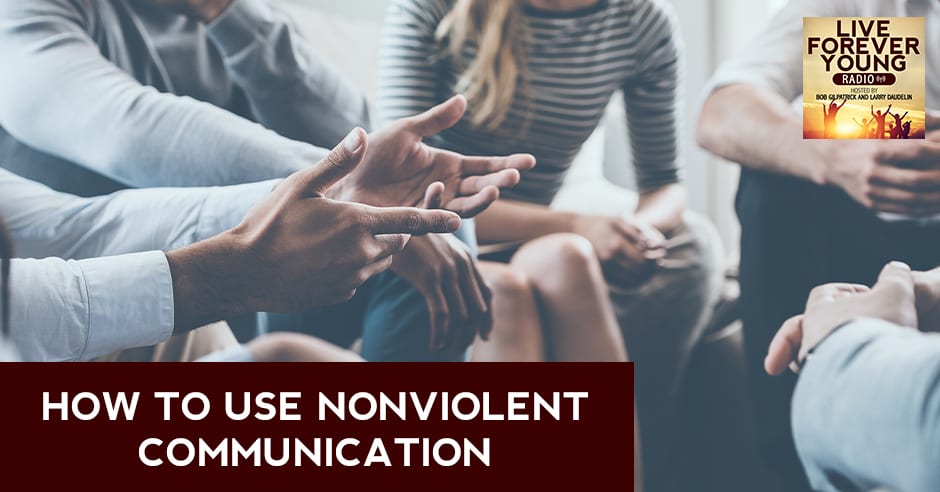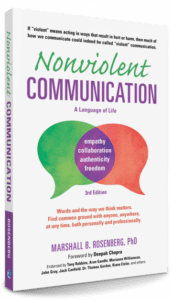How To Use Nonviolent Communication
 Communication can come in many forms, and being able to effectively communicate your needs can become a challenge. Today on the show Bob Gilpatrick and Rollie Culp discuss a great technique known as nonviolent communication and how it can help you and loved ones deepen relationships through effective communication, and resolve conflict that can come with disagreements.
Communication can come in many forms, and being able to effectively communicate your needs can become a challenge. Today on the show Bob Gilpatrick and Rollie Culp discuss a great technique known as nonviolent communication and how it can help you and loved ones deepen relationships through effective communication, and resolve conflict that can come with disagreements.
They share an easy way to implement nonviolent communication through a strategy called OFNR, which helps anyone learn how to communicate and understand the needs and feelings of themselves and others and identify resolutions easily. An informative and important discussion, especially for people who want to improve their communication and conflict resolution skills.
---
Watch the podcast here:
Listen to the podcast here:
How To Use Nonviolent Communication
A Better Way To Communicate
Rollie, how are you doing? I'm doing great, Bob. How are you doing? I'm doing well. I'm happy that we're going to be doing this topic on nonviolent communication. As people that help others live forever young, we realized that if people have excellent communication skills, it tends to reduce anxiety for themselves and for the person they're communicating with.
This is very important because anxiety causes your body to release too much cortisol at the wrong time. That's the stress hormone. It's going to then create inflammation. Inflammation is going to create disease. A lot of people, especially in 2021 start in 2020, it's a lot more tension between people.
This is a very timely topic for giving people some techniques on how to take the edge off. Instead of creating conflict with their communication to be able to have a life-giving communication that can help people connect on a very heart-centered type of way.

Nonviolent Communication: Nonviolent communication helps you to change your focus away from trying to fix things for people to understanding their feelings and needs, helping them feel better, and making communication life-giving.
I'm excited to go over this topic too. Over the years that I've worked with you, I have not only been shown but also been practiced to a lot of the nonviolent communication that you've learned over the years. One of the key things that allow us to work as a team is that what you bring to the table in regards to this particular topic.
I never asked you. You have a lot of experience in it, but maybe you could let me know or let everybody know what it is, how much experience you have. You've talked about NVC a lot. You've taught it to me but I'm not quite sure what you've done before that too.
Going way back to when I was eighteen years old, when I went off to college, I studied psychology, education and health science. I later got a Master's degree in Social Work. In a social work degree, a lot of the courses and practicums are communication skills, counseling, helping other people improve their communication skills.
In addition to that, I've attended different institutes for neuro-linguistic programming, Ericksonian hypnosis and heart-centered therapy. In regard to nonviolent communication, I went through formal training in coursework for nonviolent communication as well.
It's been enjoyable with the nonviolent communications. It's probably the most effective technique that I've learned. It was created back in the 1960s by a man named Marshall Rosenberg. He was using it for numerous different things. One in particular was helping with racial integration. If you go back to the 60s, that's when it started to begin to have racial integration. It required a therapist and teachers to help facilitate the success of that. This was one of the places where nonviolent communication was out of those therapeutic interactions in racial integration.
You were doing stuff like this since about eighteen, learning social work since you started. How old were you when this came out in the 60s? Did you learn it then? Is this something that you learned more now?
When it came out in the 60s, I would have still been a young teenager. I didn't learn it back then. 2018 was when I first learned it. We were looking at a website by a famous podcaster, JJ Flizanes. We opened up her website. The book was there on her website. I saw it. I was like, "That looks great." I started to investigate it then I started to study it with a formal teacher.
With the nonviolent communication that you've studied, this is one of the most effective ways that you've ever used in the years you've been studying this type of thing?
Going all the way back, even with what I learned in informal university social work school, this was for me the most effective technique. It helps you to change your focus away from trying to fix things for people, understanding their feelings and needs, helping them to feel better and to make a communication life-giving. At the end of the communication, everyone feels better.
Hopefully you also get accomplished what it was. You feel better as a result. When you look at the four-step process of nonviolent communication, there's an acronym that I call OFNR. This acronym is not what Marshall Rosenberg teaches. Each letter has a word that goes with it and a lot more information. I wanted to be able to remember it in sequence. I was like, "What does OFNR spell?" Spell the word, OFNR. There we have it.
This is the nonviolent communication technique, including OFNR, which is technically already there. The one thing that I was thinking about with what we do and the people that we talk to. A lot of the times when people write in, calling with a conflict or calling with an issue, sometimes they're very clear about what they need help with and then sometimes you got to do a little digging. When I have used this particular technique and speaking with people on the phone, it's proved very fruitful.
Also, what it has helped me in my life to do is reduce the anxiety that comes with having a communication with a person that may somehow turn into a conflict. That's one of the biggest things that I've taken from what you've showed me. We know that we don't want anxiety. Anxiety equals cortisol and cortisol equals inflammation.
Inflammation is the root of many diseases. With inflammation comes lots of other problems, mentally, physically health wise long-term. It is important that we not only do physically what we can do for our body, but use a technique like nonviolent communication to make it less anxious when we have to go out and interact, especially that we're re-acquisitioning into social life with COVID. I wouldn't say coming to an end but getting a little more under control, getting the vaccine out there. You got to remember what it's like to communicate again.
One example that I've seen is people that go out to a restaurant, they are experiencing new management, new employees. Many of whom don't have experience yet in being a server or a manager. People that are used to a certain level of attention and courtesy from professional wait staff are not getting that.
They're getting a brand new person who hasn't been trained yet. The workforce has dispersed itself. A lot of the people that are coming into the service jobs are brand new. It's very important for the customer to be able to be patient, understand this and communicate with the people that are working at the facility in a way that creates a generative happy place.

Nonviolent Communication: Nonviolent communication softens everything. It's like the person that you're talking to feels more relaxed and has a general readiness to believe that things are going to be okay if we can communicate in this way.
A lot of times, people will say, "It was a great restaurant. The service was great," or they'll say, "It was a great restaurant, but the service was bad. It ruined it." In this type of case, it's more going to be up to us, the customer, to create the environment, the conversation, the atmosphere because you're dealing with inexperienced people. We have an opportunity to have a big effect on them by showing them a way that tends to create connection.
It’s also to reduce conflict. Telling someone who's fairly new at a job that they might need to pay more attention to something could be an uncomfortable conversation. You're not their manager. In order to do that in a way that wouldn't offend them but will get you what you want, which is my drink, some food or maybe a little more attention because I'm looking for some ketchup, which there is a shortage on, that might not be their fault. Don't get mad at them if they can't get you to ketchup.
That's the type of thing that could be an uncomfortable conversation. That's not out at the restaurant. That's in the workplace. You have a coworker that you might not agree with on some things. The ability to have an open communication is very important, especially when there's so much conflict with what people believe here and there.
A lot of it is learning a new way of listening. It's important because sometimes when people are listening, they're not totally engaged or they've got their own preconceived notions that are being enacted even before the other person's finished speaking. Quite often, you hear somebody say, "Let me finish speaking." This is the O in OFNR, which is observation or observing.
It's listening, but it's also more than just listening. It's being present with your whole body, being able to observe and let the other person express themselves as fully as they can. Instead of looking for to interrupt with a solution, look for what the person is feeling, which is the F in OFNR. It's to observe without judgment.
Take an outside million-mile view, not how it's affecting you but how it's affecting that person and how they feel.
It’s being present with them and trying to see how they feel. Once you have listened and the person's laid out what they want to say, you can then say something to them that will either confirm or elicit their feeling. You say, "I heard what you said. It seems to me that maybe you're feeling attacked. You're feeling angry. You're feeling disappointed." It's what you think. It's not necessarily what the person's feeling but opens the dialogue in a way that says, "I'm concerned about your feelings." That's what people want. They want to make it so that they feel like they've been heard, listened to and understood.
It's your way of letting them know that you've heard them by identifying what it is that they're feeling. Instead of saying, "What do you want me to do about it? Tell me what you want," you're opening a dialogue that says, "You're saying this, which makes me think that you feel this way." If that's not the right way they're feeling, they'll correct you. They'll say, "I'm not angry. I'm disappointed because I was expecting to come home and have something ready."
One of the very helpful things is that in Marshall's books and in other books that others have written about the topic, they'll give you a list of possible feelings. In this particular case, they'll give you a list of feelings likely to occur when our needs are being met. It breaks it down. There are a lot of them. You might be feeling affectionate, alert, delighted, energetic. Feelings likely to occur when our needs are not being met, agony, disappointed, annoyed, disconnected.
For each of these categories, there are numerous feelings that are subcategory. Under agony can be anguish, bereaved, distressed, hurt, miserable, that kind of thing. As part of learning NVC, Nonviolent Communication, you want to become fluent in the language of feelings. You want to be able to put your finger on feelings, know that there are all different derivatives of different feelings. You yourself have this fluent command of the world of feelings. Not only it's helpful for yourself, identifying your own feelings but in your communications.
Once you're looking at the feelings and you get the feeling down, whether or not you're right, when you say, "This is how I think you're feeling," then the person either corrects you or goes forward from there, that's going to help you understand what needs to be done.
Understand what their need might be. The need is something that is going to help with the feeling that they're having. That's the end in OFNR. The N in OFNR is a person's needs. As the one who's skilled in NVC, you might say to the person, "You're feeling annoyed. It seems to me that maybe you need this." At that point, you also have an opportunity for the person to say, "That would be great.
What I think I need is this." You're getting closer to a resolution. You're also making a connection by showing empathy. "I'm empathizing with you by guessing as to what you might need." That's very respectful. It's like you were saying, "Rollie, I'm not going. What do you want me to do? It seems maybe you need." The person who's receiving this communication is like, "This is a connection.
This is real. This person is interested to make a connection with me." In the R part in OFNR, R is for request. A request can be made by either party. One person could directly say, "I'd like to request. I want you to do." If that's not forthcoming, the person who's learned it in NVC can say, "It seems to me that maybe if you requested this, that I could respond like this." A request needs to be respectful. It needs to be reasonable. If someone's requesting something that you cannot do, it's going to pull the string out of this hole of OFNR.
It's not going to work. It's learning the skill of how to frame a reasonable request. Step one, we can make this reasonable request that is going to help to fulfill this need, which is going to make me feel differently. It's going to resolve in some small way or perhaps completely this feeling that I have of anger towards this situation, observe without judgment, help identify feelings, help identify needs, help in the construction of a reasonable, respectful request.
Rollie, I think you felt this too. When people use this type of communication, it softens everything. It's like the person that you're talking to feels more relaxed and has a general readiness to believe that things are going to be okay if we can communicate in this way. We know that having a feeling that things are going to be okay is extremely important. If you're not of the feeling that things are going to be okay, you're in anxiety, your heartbeats differently.
The signal to the amygdala is different. The signal from the amygdala to the frontal cortex is different. The signal from the frontal cortex to the heart is different. You have very little heart rate variability, which we discussed in the program on Inner Balance from HeartMath.
The show we did called Positive Mind, Positive Health is where we go into detail about how that connection to brain, to amygdala, to the neurites in your heart can all have an effect.
This technique goes hand in hand with it. When people are communicating in this way, they have confidence. They have a sense of peace and a general readiness to believe that things are going to be okay.
We've talked about the stat before in many shows. One of them was dealing with anxiety, depression and trying times. We talked about how most of the time, American specifically, think things are not okay. Ninety-nine percent of the time, we're of the belief that things are not okay. That only leaves 5% of positivity.
This type of communication, that's nonviolent, that's also called compassionate communication. It's one of the ways that we can help each other to change that 95% and make that number lower. Make the number where we believe everything is okay much higher. This works in many different types of situations. It works in interpersonal situations with your family and with your friends.
A quick aside on that, I'm getting married soon. Congratulations. I've been with my fiancée for years. We should have done it a long time ago but this has given me a lot of time to practice NVC with her. There certainly has been some times that maybe she's felt like I haven't understood how she feels. Maybe I think that she doesn't understand how I feel but to be personally honest, this is one of the things that I've done.
I've said, "It looks to me that you feel that I'm not helping as much. That probably makes you frustrated." The need here is for me to step up a little bit more. That's a completely reasonable request. That's OFNR. I've used that. It helped to dispel the situation that could probably turn into some fiery, horrible argument. We don't want that.
That means things are not okay. When you're stuck in this loop of things are not okay, that's when you begin the stress response that results in this extra cortisol and results in inflammation. This show being Live Forever Young, we don't want that. A big part of living young and not aging too fast or getting sick is to keep your anxiety down.
It's one of the best ways to stay alive longer. Rollie, this works in the workplace also, the same type of dynamics happen with coworkers, a person who's a manager and a person who's reporting to a manager. It's very helpful, particularly for the managers to know how to execute this OFNR. We also use this with customer service.
As I did with my fiancée, we've had people call in that weren't necessarily mad at us, but they were in a certain mood. We had to identify what that was coming from. Help them maybe even understand where those feelings could have been coming from or even what those feelings are. Sometimes people call in upset about certain things that happened in their life. We're sitting here. We talk about supplements. That's not going to cut it.
We need to be able to, as a customer service team, help the people that call in, even if it's just with getting in the right frame of mind. Anxiety, that's going to create inflammation. That's going to lower your life here. We live forever young here. We want to live as best as we can for as long as we can. By having that ability to use this in our customer service experience, not only helps resolve a conflict but helps make the person on the other end feel better physically because they're not as anxious.
When you look at how this can work with over the phone, it relates to social media. People go online. They say whatever they want. They don't consider the feelings of the other person on the end of the other computer. If people who were big with social media, Instagram, Twitter, whatever the case was, might think twice before posting something and use the OFNR, it might lead to a little bit more helpful, peaceful communication and dialogue online. I'm sure with the news and what people don't agree on, one of the biggest breeding grounds for this type of bad feeling is social media.
There are kids who get bullied from school that can be taken to all parts of life as a child. To be able to teach this kind of thing to a child and let them learn how to communicate very effectively with someone of their age that may have been bullying others, may have been not knowing why they're bullying others. If you could impart this onto younger minds, it would only be helpful.
In regard to myself, I was talking to a gentleman on the phone. He was upset. He had talked to somebody else who wasn't quite getting the connection with him. It was hard to figure out. I started listening to him and I was like, "It seems to me that you're feeling upset. Is it that you're upset about something? What is it with you? Are you okay?" Right away quickly, it was, "It's not me. My wife has stage four cancer." He was so upset when he called in.
He wasn't even able to get that across until the right question was asked. At that point, you can begin then to empathize with the person and gradually help to identify what needs there might be. In this case, it's a need for both people. In a situation like this with the wife going through chemotherapy for stage four cancer, she desperately needed a nutrition product to help her stay healthy and not have muscle wasting.
Sixty percent of the people that die from cancer die from muscle wasting. We have a product that works for that, that helps people gain muscle weight while they're going through chemotherapy. This was a need for her. Equally important, the gentleman had a need to be able to manage his stress, his anxiety and his fear. This is where it's acceptable for us to say, "It sounds to me that you might need a little bit of help in reducing your anxiety over this. Have you watched our videos yet on the emotional freedom technique, which we've talked about before? Have you learned to do the ultimate mind calming exercise?"

When someone is very sick quite often, they also become very impatient and can be rude to their spouse and sometimes extremely so. Would you like to hear a little bit about communication techniques in a book you can get called Nonviolent Communication?
It could be very helpful for you learn to do some tapping. Use these techniques and these books, communicating with your wife. In this way, a great body of work like Marshall Rosenberg's can be used in a very specific situation, even years later to be able to help someone on the other end of the phone.
Also, if they come to visit us in the office, the same type of technique is very helpful. Quite often, I'll also even take notes when I'm speaking to someone. You write everything down. It may be that you need to identify a feeling in regard to numerous things. You don't want to lose track. You want to make sure you cover everything. If you don't, you might miss the most important thing.
In the end, it's all about trying to not only help the person but give them some information and tools that they can use. Not only help themselves and others but take a look introspectively at what it is that they might need. Maybe the person is angry because they don't know what they need or they don't take enough time like in the case with the guy you were talking to.
He's so worried about his wife that he's probably never identified for himself what he needs. What he needs is some help. When you have someone there that can help identify the need, possibly resolve it and then request or listen to his request, that makes a whole game changing of a difference.
Rollie, that's the overview. If people want to learn more about it, they can get Marshall Rosenberg's book. There's an Institute of Nonviolent Communication that has their website.
There's this one that we've been working with. That's the companion workbook that goes along with the book. If you want to take it further, become a practitioner, this is a great workbook. There are also many people that are certified to be teachers of nonviolent communication. You can find those through the institute.
In the end, it's all about helping people realize what they might need, how we can help them. That's what we're here to do.
Rollie, thanks again for being here on the show.
Thank you everybody for reading.
We'll see you on the next episode.





Leave a comment